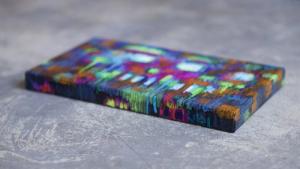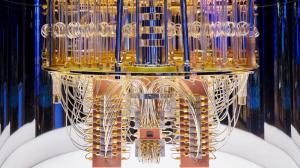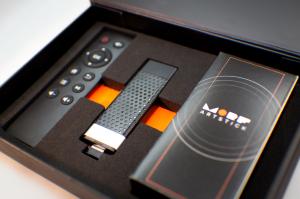Sotheby’s Showcasing Art’s Quantum Leap
Pindar Van Arman Creates World-first Quantum Computer-Born, AI-Animated NFT Memorialized by a Robot-Painted Canvas Artwork and Showcased on a MORF AI ArtStick™
Successful bidders will receive the NFT (non-fungible token) of 'Quantum Skull', plus a signed acrylic on canvas painting (10 in by 18 in), and a MORF AI ArtStick™ enabling people to experience the quantum artwork in high resolution as a digital canvas on any TV or screen. Sotheby’s estimate is $100,000 - $150,000 USD with no minimum reserve set.
“Procedurally generated by a quantum computer, interpreted by AI and painted by a robot, ‘Quantum Skull’ begins at the atomic level and transforms into a painted canvas. Giving collectors my artwork on a MORF AI ArtStick enables them the flexibility to display and enjoy their collection anywhere. This adds a whole new dimension to enjoying my art,“ said Pindar Van Arman.
“Pindar Van Arman’s ‘Quantum Skull’ is an incredible example of how exponential technologies like quantum computing, AI and robotics can unleash the power of human creativity and how the MORF AI ArtStick™ is enabling digital art collectors to showcase this incredible artwork on the best canvas possible, their TV,” said Scott Birnbaum, CEO and Co-Founder of MORF AI.
Van Arman used AI that studied 1000s of custom generated 32x32 pixel images with references to many of his early childhood memories including his time with games like Mario Bros, Space Invaders, Pac-Man, and Adventure. This training data was sent into Generative Adversarial Networks (GAN) that searched for the underlying patterns in the 8-bit art, and imagined 1000s of new images in their likeness.
Working from the GAN generated imagery, the robot attempts to make the canvas look more like the imagery from the GAN one brush stroke at a time, even as that image continues to generate and change. Periodically, the robot pauses and takes a picture of its progress on the canvas. It then uses the photo to compare its progress to the imagery being imagined by the AI. Based on the comparison it decides on the next set of brushstrokes and continues painting until Van Arman decides the painting is done. It is this way that the painting is born from the AI’s imagination and creative feedback loops.
Traditional computers store information in binary where each bit is either on or off, a one or zero with certainty. Quantum computers use qubits which can be on or off but also could be both on and off. This describes superposition until measurements can be made. Instead of certainty, quantum computers use probabilities. Quantum computing takes advantage of several key concepts including quantum superposition, entanglement, and interference. Actual measurements of quantum superposition were made by artist Russell Huffman on IBM's Montreal quantum computer and were used to procedurally generate the piece. When the artwork is viewed, an 8bit skull is moving from place to place, existing in superposition until observed, then revealing it was elsewhere all along. Its form mimicking the generative process that created it. This work takes another step further as 'Quantum Skull' is also a physical painting created from observation at an atomic level by Van Arman's AI- trained robot.
Click here to learn more or bid on 'Quantum Skull' or key into https://morf.gallery/artist/pindar-van-arman/ to see more Van Arman originals on canvas.
About:
MORF AI is a Silicon Valley tech startup infused with the excitement of Hollywood delivering fine art to digital screens by award winning artists using breakthrough technologies like AI, robotics and neuroscience featuring moving paintings, lost art resurrections, dreaming photographs, 3D moving fractals and creative robots. MORF AI adds a new experiential dimension with an industry-first ArtStick™ that transforms any TV or digital screen into a mind-expanding fine art gallery that takes premium collecting to a new level for art lovers, collectors and NFT art investors. ArtStick™ is a trademark of MORF AI, Inc.
Pindar Van Arman is an American artist and roboticist who designs painting robots that explore the differences between human and computational creativity. He is a founding artist at MORF AI. Since his first system in 2005 he has built multiple artificially creative robots earning multiple accolades including a TEDx Talk, making the Shortlist at Barbican’s DevArt Competition, and First Prize in the Robot Art 2018.
Scott Birnbaum
MORF AI, Inc.
+1 657-667-3631
scott@morf.gallery
Visit us on social media:
Twitter
LinkedIn
Other
Pindar Van Arman's 'Quantum Skull'
Legal Disclaimer:
EIN Presswire provides this news content "as is" without warranty of any kind. We do not accept any responsibility or liability for the accuracy, content, images, videos, licenses, completeness, legality, or reliability of the information contained in this article. If you have any complaints or copyright issues related to this article, kindly contact the author above.



